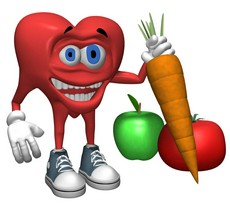
In part 1, I addressed the bleak stuff that humans have to deal with to varying degrees, so let’s now talk about nutrition and exercise.
WHAT CAN WE DO TO DO BETTER?
A statement taken from the National Institute of Health (NHLBI):
" Diet, weight control, and increased physical activity are the first steps in the prevention and treatment of coronary artery disease." This is fundamental.
WHERE DO MOST OF US LIVE WITH FOOD IN AMERICA?
We have a higher intake of red meat, processed meat, refined grains, sweets and desserts, French fries, high-fat dairy products: I know, I know- All the Good Stuff!
WHERE SHOULD WE BE?
Higher intake of vegetables, fruits, legumes, whole grains, fish, poultry: (Yuck!)
The American Heart Association recommended in 2006 Diet and Lifestyle Recommendations for Cardio Vascular Risk Reduction:
Consume an overall healthy diet rich in fruits, vegetables, whole grain, high- fiber foods and include fish at least 2X/ week.
Aim for:
- A healthy body weight
- Recommended levels of LDL, HDL, and Triglycerides
- A normal blood pressure
- A normal blood glucose level
DO THESE THINGS!:
- Avoid use of and exposure to tobacco products.
- If you smoke, STOP! There are programs in place for guidance and support. Hoag Hospital offers a smoking cessation program.
- Limit saturated fat to < 7%; trans fats to <1%; and cholesterol to < 200 mg/ day.
Do this by:
- Choosing lean meats and vegetables
- Selecting fat-free or skim milk-1 or 2% fat, and low- fat dairy products.
- Minimizing intake of partially hydrogenated fats - Minimize intake of beverages and foods with added sugars
- Choose and prepare foods with little or no salt
- If alcohol is consumed, do so in moderation
Additionally, eat a higher content of MUFAs. (Mono Unsaturated Fatty Acids- namely Omega's! By doing so, you will promote better lipid (cholesterol) levels, improve blood pressure, improve glucose levels and insulin sensitivity.
If you don't have documented coronary artery disease, eat a variety of (preferably oily) fish at least twice a week. Increase oils and foods rich in alpha- linolenic acid (flaxseed, canola, soybean oils; flaxseeds and walnuts).
If you do have documented coronary disease, consume about 1 to 2 grams of EPA +DHA per day.
(These are the 2 specific omega 3's).
If your triglycerides are very high (200 or greater) 2 to 4 grams of EPA and DHA are recommended.
The types of fish with the highest levels of EPA +DHA (over 800 mg / 3 oz serving) are:
- Sardines (835),
- Rainbow trout (980),
- Mackerel (1046),
- Bluefin tuna (1280),
- and the various Salmons (900 to 1875).
Patients are always asking me what it is they can do naturally to lower their cholesterol rather than taking a medication. A study ( Jenkins, JAMA, 2003) utilized something called the Portfolio Diet, that was low in saturated fat, and low- fat dairy foods, and added 1 gram of plant sterols, 21 grams of soy protein, 10 grams of viscous fibers, and 14 grams of almonds. Lowering of total cholesterol and LDL, was in the 30% range, almost as good as using the statin called lovastatin. - Viscous fibers increase bile acid losses . 10 grams of psyllium can lower LDL by about 6%.
- Soy proteins reduce liver cholesterol synthesis, and increase LDL receptors; 45 grams of soy protein can lower LDL by about 10-12%.
- Plant sterols reduce cholesterol absorption. 1-2 grams can lower LDL up to 13%.
- Almonds have an LDL lowering effect.
WHAT ABOUT ALCOHOL?
One drink a day improves coronary risk, vs. teetotalers, though increased amount of alcohol is associated with higher mortality risk from numerous causes. There is no difference between red and white wine statistically, though red wine has resveratrol which may have benefits to the integrity of the arterial wall. Alcohol In moderate amount has beneficial effects to lipid metabolism and increases HDL, and lessens clot risk.
As a rule of thumb, women are " allowed" one to 1-1/2 drinks a day, and men, up to 2 drinks a day, meaning one drink equals 12 oz beer, 5 oz wine, 1-1/2 oz (shot glass) 80 proof spirits.
WHAT ABOUT PHYSICAL ACTIVITY?
26% of adults in the USA report being physically active (>30 minutes) on most days of the week. When physical activity was measured by a device that detects movement, only 3 to 5% of adults obtained > 30 minutes of moderate or greater intensity 5 days a week! Over 40% of adults report no leisure time physical activity.
The recommended level of physical activity for general health is 150 minutes/ week which is 30 minutes / day X 5 days/ week. (20 to 30,000 steps / week)
For weight loss, it's 250 to 300 minutes / week which is > 60 minutes / day, 5 days a week or more.
(40 to 60,000 steps/ week.
Help in putting together an exercise program is very helpful, and assessed around Frequency, Intensity, Time ( duration)- FIT
Lifestyle activities are also very beneficial if you are not directly into exercise per se, such as stair climbing, yoga, walking, hiking, gardening, dancing, etc.
Simply put, you want to do a certain amount of aerobic activity on a daily basis, and certainly 4 to 5 times a week. The formula to apply is 220 minus your age. 90% of that is your aerobic threshold. You don't have to get there, nor do you need to exceed that. For most people not a great idea to exceed that. Most aerobic conditioning is in the 75 to 90% range. BUT, 65 to 75% will allow for caloric reduction and “fat burning”.
- if you are 60: (220-60=160) 160 heart beats per minute is the 100% maximum. Imagine you are running away as fast as you can from a wild tiger! 80% is 128 bpm and 90% is 144 bpm. So a good workout to sustain for 20 to 40 minutes is a heart rate in the 130’s…AND you don't have to be dogmatic about it, just do it and enjoy! ( If you are on certain medications that can have a slowing effect on heart rate such as beta blockers, these numbers don’t apply… in that event , just sustain an intensity of activity that has you breathing hard, and you feel like you are exercising and accomplishing something…this is not walking the dog!)
AND DON’T STOP!
When I address these issues to patients, I always encourage comfortable walking for several minutes at the beginning and at the end, and in between, do a power walk for as long as you comfortably can. Note how long it lasted until you wish to slow down, and repeat the same daily for two weeks. After two weeks add another 2 to 3 minutes to the power walk per week, and gradually, your aerobic capacity, and conditioning can't help but improve. The other aspects of exercise I address, are stretching for continued flexibility, some weight or resistance work to develop muscle strength and tone, and balance. With aging, balance gets compromised and you need to work on it!
The tough part is that it takes a lot of exercise for calorie reduction, versus the amount of food to add caloric gain. For example, 40 minutes of intense aerobic exercise is worth about 400 to 500 caloric loss, which is about one piece of chocolate cake or a slice of pizza!
Resistance training (free weights or machines) does not promote clinically significant weight loss, although it may increase muscle mass which may increase 24 hour energy expenditure.
Energy intake ( food) is influenced by many environmental factors: the composition and density of foods, the volume of foods, portion size, visual cues, prior intake patterns, variety, and setting ( alone vs. group, other stimuli, etc.) meal replacement programs (protein shakes for example) may help drop weight by 5 to 10% if used daily for one or two meals.
Though low carb diets are often helpful in dropping weight, they tend to rebound back up to initial levels when stopped.
The "diet" that I recommend in my practice which is advised by the National Lipid Association, and now by the American Heart Association, and American College of Cardiology, is the Mediterranean Diet, which is much more an approach to nutrition rather than a diet. This tends to lower weight more gradually and keep it off and also has most of the heart healthy benefits that have been previously discussed in this essay.
Also be aware of the GLYCEMIC INDEX, which is a measurement of the glucose level of certain vegetables and fruits. You can look these up in Google, but foods such as white rice, potatoes, corn flakes and other cereals, bananas, carrots, white bread, white spaghetti are all on the higher side.
Here are a few secrets of people with successful long term weight management:
* 78% of people eat breakfast every day
* 75% weigh themselves at least once a week
* 62% watch less than 10 hours of TV/ week
* 90% exercise, on average about 1 hour/ day
Here are some tips that help you to lose weight:
* Keep a journal: it helps you create patterns and reinforces the mission.
* Daily exercise: burns calories and improves overall health
* Protein at every meal: maintains muscle mass and higher satiety quality
* Regular eating patterns: Minimizes grazing and binging
* Take it slowly: healthy patterns develop over time
* Meal replacements (1 or 2/ day): facilitates long term weight loss
* Find a partner or attend a support group: this helps to maintain new lifestyle habits
* Eat a Rainbow : Fruits and vegetables provide variety and fill you up.
This concludes Part 2 of Not So Simple Tidbits for a Healthier Lifestyle.
In Part 3, I'm going to discuss some other areas of importance attributed to helping you live a longer, healthier, and happier life.
Until then, get out and move your body and follow the above dietary guidelines!


 RSS Feed
RSS Feed